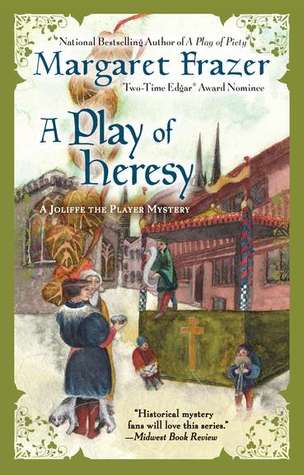I received this book for free from the library in exchange for an honest review. This does not affect my opinion of the book or the content of my review.
Source: the library
Clerk's Tale
by
Margaret Frazer
historical mystery in a paperback edition that was published by Berkley on December 3, 2002 and has 320 pages.
Explore it on Goodreads or Amazon
Other books by this author which I have reviewed include A Play of Knaves, A Play of Lords, A Play of Treachery, A Play of Piety, Murder Most Medieval: Noble Tales of Ignoble Demises, A Play of HeresyCoventry, Easter, plays, murder, spies, guilds, mercer, jealousy, Judas, theater, directing, acting, suicide, costumes, religious plays,, The Novice's Tale, The Servant's Tale, The Outlaw's Tale, The Bishop's Tale, The Murderer's Tale, The Boy's Tale, The Prioress' Tale, The Maiden's Tale, The Squire's Tale, The Bastard's Tale, The Hunter's Tale, The Widow's Tale
Eleventh in Dame Frevisse (Frazer has changed the name of the series) medieval mystery series revolving around a canny nun in Oxfordshire. This particular story takes place at Goring.
My Take
Poor Frevisse. She keeps being dragged into situations she’d rather avoid. The cultural rules of the day force Frevisse to play companion and emerge out into the world. Again.
I do find it interesting to gain this perspective on the religious life with a nun who [through Frazer] communicates why she finds the cloister so attractive. It’s still not where I would want to be, but I appreciate the understanding of it. That and not having it rammed down my throat!
If you’ve been following this series, this is a DO NOT MISS. If only so you can celebrate the deadee! Wahoo!! And, it’s uncanny *rip that tongue out of me cheek* how it’s only Frevisse’s powers of thought/observation that are the only way to win the day. And, in spite of my unholy joy at the start, her talents are very much required to prevent a very sad injustice amongst the many others.
Christopher remembers how very useful Dame Frevisse’s brain can be and insists on her help. Then there are the deaths that keep occurring. Well, what can you expect when there’s a sociopath on the loose?
This story was notable for two things: the marriage arranging customs and Master Gruesby’s almost obsessive desire to not be noticed. It’s a confusing exposé of law and the custom of arranging marriages with people everywhere willing to lie, cheat, and kill to attain their desires. Yup, not much has changed down through the centuries. It does make me grateful for today’s law — at least we don’t have to worry about whoever’s in power twitching the reins quite like they have to worry in 1446 England!
It’s a busy little clique with Stephen inheriting his father’s tomcatting ways, even though he loves his young wife. The Champyons are busy pushing at everyone and being nasty. Master Gruesby is terrified as to what will become of him with Montfort’s death. The political machinations and considerations between Lovell and Suffolk are very confusing. In fact, about the only bright spot in this is Mistress Montfort’s attitude toward her deceased husband. Oh, yeah…it is PAR-TAY time! Well, I suppose I should count Gruesby’s “fear” of Dame Frevisse — she notices too much!
As always, it’s intriguing to watch Frevisse figure it all out.
Even better…ding-dong, the Montfort’s dead, sing it high and sing it low…!
The Story
It’s pure chance that brings Domina Elisabeth and Dame Frevisse to Goring. The domina’s cousin is dying and has asked that she be allowed to come visit. Naturally Frevisse comes along as companion. But, someone has killed the former crowner, Montfort. Yeah!! Nobody is gonna miss this guy.
As the new escheator, Mister Montfort was investigating claims against Stephen Lengley that would prevent his inheriting a manor which Rose Bower brought to her marriage to his father, Sir Henry Lengley.
A simple enough investigation that becomes complicated by a corrupt government official and lying witnesses.
The Characters
Master John Gruesby is the escheator’s clerk, the former crowner who has given Dame Frevisse such trouble in the past. It’s he who finds the body, and this act sets up a storm of nerves. Morys Montfort was clawing his way up in the world and aligning himself with Suffolk; he’d recently purchased the post of escheator. Montfort’s son, Christopher, whom we met in The Reeve’s Tale, 9, has moved into his father’s old crowner position.
Dame Frevisse is one of the nuns at St. Frideswide’s, and she can’t seem to help interpreting clues. Domina Elisabeth is still in charge of St. Frideswide’s; her acumen is helping to drag the priory up from its fall into debt. Dickon is the priory steward’s son and a great help on this journey along with Ron and Bartelme.
The gossipy Lady Agnes Lengley enjoys a privileged relationship with the nunnery in Goring. Emme and Letice are her ladies-in-waiting. Stephen Lengley is her, um, flexible grandson; Nichola is his new, beloved wife. Philip Haselden is Nichola’s father, Lovell’s man, and has had the right of Stephen’s marriage. Allison Haselden is a timid woman. Harry was Stephen’s older brother, but he died.
Cecily Bower (Henry’s wife’s sister) and her husband, James Champyon, are contesting Stephen’s legitimacy to inherit. Their children are Rowland Englefield, Cecily’s unmarried and carefree son from an earlier marriage, and the beautiful and widowed Lady Juliana.
Domina Matilda runs the St. Mary’s nunnery in Goring where Sister Ysobel, Domina Elisabeth’s cousin, is dying of a lung sickness. Master Garner is the nuns’ gardener. Sister Joan is the infirmarian. Sister Maud is the sacristan. Sister Mariota Coleshill made a deathbed statement.
Part of the problems with deciding about the manor is the polite struggle between the Marquis of Suffolk and Lord Lovell, both of whom are attempting to increase their political strength.
The Cover and Title
The cover is a vertical split with a colorful graphic on the left of an enclosed garden overlooked by buildings with a dead man lying on the grass and, on the right, a solid colonial blue to showcase the text. The title has its own red box while the data, series info, and author’s name stands out against the blue.
The title warns of the character who is the focus of this particular tale, for it’s The Clerk’s Tale in this story.














